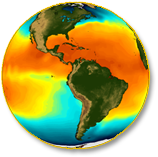Emission Scenarios  Concepts
Concepts
The four future scenarios adopted by the IPCC Fifth Assessment Report (AR5) called Representative Concentration Pathways (RCPs) are defined by their total radiative forcing - or cumulative measure of human emissions of greenhouse gases expressed in Watts per square meter (W/m2). The pathways are used for climate modeling and project out to 2100. They describe four possible climate futures, all of which are considered possible depending on how much greenhouse gases are emitted in the years to come.
The four RCPs; RCP2.6, RCP4.5, RCP6, and RCP8.5, are named after a possible range of radiative forcing values in the year 2100 relative to pre-industrial values (+2.6, +4.5, +6.0, and +8.5 W/m2, respectively).

The RCPs are consistent with a wide range of possible changes in future greenhouse gas (GHG) emissions.
- RCP 2.6 assumes that global annual GHG emissions peak between 2010-2020, then decline substantially thereafter.
- Emissions in RCP 4.5 peak around 2040, then decline.
- In RCP 6, emissions peak around 2080, then decline.
- In RCP 8.5, emissions continue to rise throughout the 21st century.

